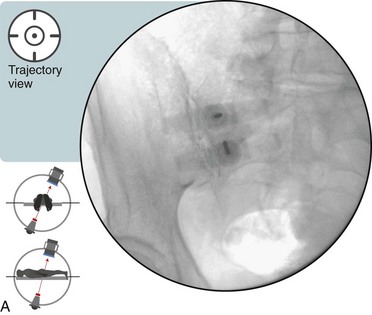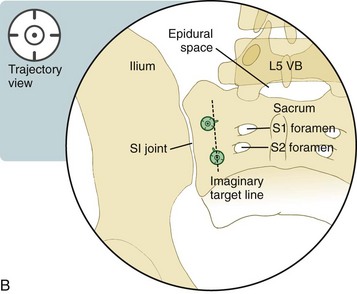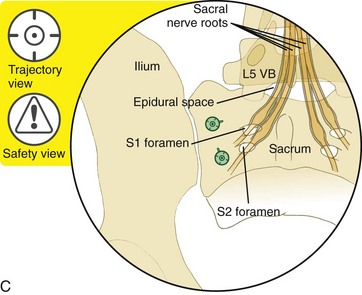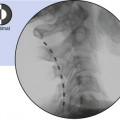Chapter 7 Sacral Insufficiency Fracture Repair/Sacroplasty, Short Axis Approach
Sacral insufficiency fractures are a common cause of low back pain. This is often under diagnosed as a result of low clinical suspicion. These fractures are a consequence of the imposition of physiologic stresses onto weakened bone. Spontaneous fracture of the osteoporotic sacrum was first described in 1982.1 It manifests clinically as back and/or buttock pain with or without lower limb pain referral.1–3
The traditional therapeutic algorithm for sacral insufficiency fractures consists of limited bed rest,2–4 partial weight bearing, and early mobilization.5 The overall 1-year mortality rate associated with pelvic insufficiency fractures is 14.3%, and 50% of affected patients will not return to their prior level of functioning.8–10 Despite a favorable natural history, more aggressive treatments may benefit patients who are incapacitated by painful sacral insufficiency fractures.
The percutaneous injection of polymethylmethacrylate into fractured vertebral bodies (i.e., vertebroplasty) has been safely performed to successfully treat painful osteoporotic compression fractures.11–15 A natural extension of the application of vertebroplasty is the percutaneous injection of synthetic bone cement into the fractured sacrum (i.e., sacroplasty) to treat persistent symptoms and disability.
There have been several articles that have documented the efficacy of sacroplasty,16–19 including two large prospective studies.20,21 Sacroplasty appears to be a safe and effective treatment for painful sacral insufficiency fractures. The rate of improvement is rapid, with a more than 50% reduction in pain achieved before the postprocedure discharge of the patient. Pain reduction occurs primarily within the first 3 months, but it is sustained through 12 months after treatment.
Note: Please see page ii for a list of anatomical terms/abbreviations used in this book.
 Trajectory View
Trajectory View
Confirm the level (with the anteroposterior view) before obtaining the trajectory view.
 The fluoroscope is obliqued contralaterally from the side being treated until one can superimpose the medial and lateral aspects of the sacroiliac joint. This could be approximately 5 to 25 degrees contralateral oblique. If the posterior iliac crest is in the way, caudal or cephalad tilts of 0 to 25 degrees may be necessary.
The fluoroscope is obliqued contralaterally from the side being treated until one can superimpose the medial and lateral aspects of the sacroiliac joint. This could be approximately 5 to 25 degrees contralateral oblique. If the posterior iliac crest is in the way, caudal or cephalad tilts of 0 to 25 degrees may be necessary.
 The needle tip destination is at the midpoint of the imaginary line drawn between the lateral aspect of the dorsal sacral foramina and the sacroiliac joint.
The needle tip destination is at the midpoint of the imaginary line drawn between the lateral aspect of the dorsal sacral foramina and the sacroiliac joint.
 Use an 18-gauge needle to first penetrate the skin. Use a mallet to gently tap either a 13- or 11-gauge trocar into the periosteum.
Use an 18-gauge needle to first penetrate the skin. Use a mallet to gently tap either a 13- or 11-gauge trocar into the periosteum.
 Because this is the trajectory view, the needle entry position should be parallel to the C-arm beam (Figure 7–1).
Because this is the trajectory view, the needle entry position should be parallel to the C-arm beam (Figure 7–1).









